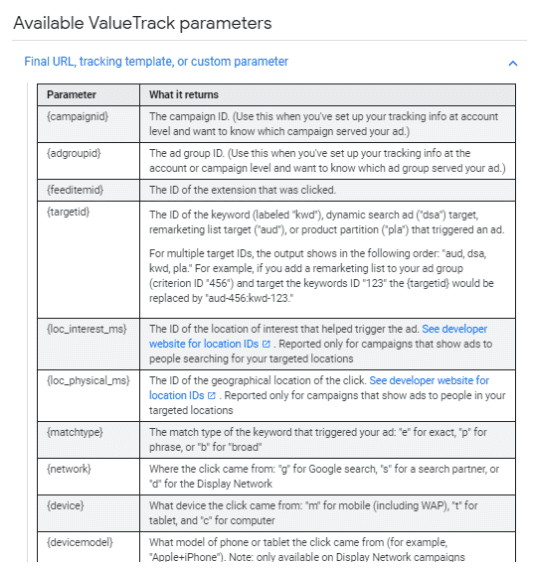Welcome to part 1 of 2 in our guide to using localization tactics to seriously boost conversion rates! Tune in next week for the final post in the series.
People often overlook the value of Bing and Google ValueTrack Parameters, a type of URL parameter that collects information about ad click sources, because of the relative ease and simplicity of Bing and Google Auto-tagging, which tags your ads with the appropriate UTM parameters that Google Analytics needs to categorize your paid search, display, and YouTube traffic.
However, Bing and Google ValueTrack Parameters serve quite a few purposes that auto-tagging can’t accomplish. Namely, it is a dynamic method for digital marketers to populate pertinent information, like keywords and creative, into ad URLs. The following case study will show you how to leverage Bing and Google ValueTrack Parameters for fluid, customizable landing pages.
Bing ValueTrack Parameters:

Google ValueTrack Parameters:

The Challenge of Un-Localized Campaigns
 A healthcare client with a vast network of clinics across the country had built a separate ad campaign for each city to drive traffic to specific clinics’ landing pages. As a result, the client’s account contained nearly 10,0000 separate campaigns based on the amount of cities our client serviced.
A healthcare client with a vast network of clinics across the country had built a separate ad campaign for each city to drive traffic to specific clinics’ landing pages. As a result, the client’s account contained nearly 10,0000 separate campaigns based on the amount of cities our client serviced.
The challenge: Bing and Google only allow 10,000 campaigns per account — not to mention the migraine that accompanies managing even a portion of that amount. How could we centralize this daunting campaign in a way that was easier to manage, analyze, optimize and most importantly, gain meaningful insights?
Our paid media team brainstormed ways to consolidate the campaign structure. A main issue from the jump was geo-modified keywords and how they were tied to campaigns — every targeted keyword phrase included the name of a city or town that the client serviced.
The first remedy was to utilize Dynamic Keyword Insertion (DKI) to maintain the city-specific nature of the ads. DKI is a search feature that allows our paid team to populate ad elements dynamically, based on targeted keywords. In short, we simply needed to develop a few ad copy templates and use DKI to “localize” them.
Utilizing Bing & Google ValueTrack Parameters
Then we realized we can use the “{keyword}” Bing and Google Value Track parameter to populate targeted keywords within the landing page URL dynamically. This allowed us to use the keyword information within the URL to dynamically provide a city-specific landing page to incoming searchers.
We accomplished this by collaborating with the client’s development team to create a keyword mapping structure based on keywords within the campaign. Each keyword was mapped to the city-specific landing page, which meant that the website could recognize each keyword within the “{keyword}” Bing and Google ValueTrack parameter. This step allowed landing pages to render in a fraction of a second and provided a fast, relevant experience for the searcher.
Remember the 10,000 campaigns? This allowed us to consolidate them into a single campaign.

Consolidated Campaign Results
Using this new methodology, we were able to glean meaningful insights from our search tactics. Consolidating the conversion data into a single campaign allowed us to better leverage Bing and Google Ads, whose auto-bidding algorithms require a minimum level of conversion data prior to use and won’t work well without sufficient data. Small amounts of data spread out amongst 10,000 campaigns wouldn’t allow us to harness the power of Bing and Google Ads’ algorithms.
The real kicker though, was that localized campaigns ensured searchers were landing on pages relevant to their needs, thus supercharging conversion rates.
But, as always, we had our sights set even higher. Tune in to next week’s post, where we’ll cover the next phase of our localization journey.
In the meantime, talk to our paid team about whether localizing your campaigns is the right move for your business.






